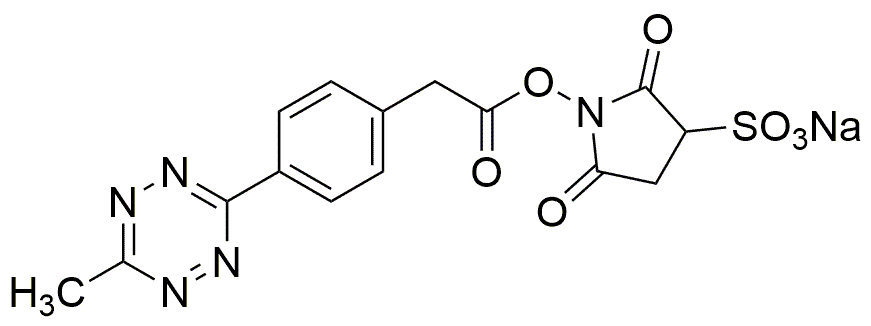Methyltetrazine-Sulfo-NHS ester is widely utilized in research focused on:
- Bioconjugation: This compound is commonly used to attach biomolecules, such as proteins or antibodies, to surfaces or other molecules, enhancing the development of targeted therapies and diagnostics.
- Fluorescent Labeling: It serves as a linker for fluorescent dyes, allowing researchers to visualize cellular processes in real-time, which is crucial in cell biology and drug discovery.
- Drug Development: The ester form facilitates the modification of drug candidates, improving their pharmacokinetic properties and bioavailability, which is essential in pharmaceutical research.
- Diagnostics: Used in the creation of assays for detecting specific biomolecules, this compound plays a vital role in developing sensitive diagnostic tools for various diseases.
- Research in Neuroscience: It is employed in the study of neurochemical pathways, helping scientists understand brain functions and disorders, thus contributing to advancements in neuropharmacology.
Información general
Propiedades
Seguridad y normativas
Aplicaciones
Methyltetrazine-Sulfo-NHS ester is widely utilized in research focused on:
- Bioconjugation: This compound is commonly used to attach biomolecules, such as proteins or antibodies, to surfaces or other molecules, enhancing the development of targeted therapies and diagnostics.
- Fluorescent Labeling: It serves as a linker for fluorescent dyes, allowing researchers to visualize cellular processes in real-time, which is crucial in cell biology and drug discovery.
- Drug Development: The ester form facilitates the modification of drug candidates, improving their pharmacokinetic properties and bioavailability, which is essential in pharmaceutical research.
- Diagnostics: Used in the creation of assays for detecting specific biomolecules, this compound plays a vital role in developing sensitive diagnostic tools for various diseases.
- Research in Neuroscience: It is employed in the study of neurochemical pathways, helping scientists understand brain functions and disorders, thus contributing to advancements in neuropharmacology.
Documentos
Hojas de datos de seguridad (HDS)
La SDS proporciona información de seguridad completa sobre la manipulación, el almacenamiento y la eliminación del producto.
Especificación del producto (PS)
La PS proporciona un desglose completo de las propiedades del producto, incluida la composición química, el estado físico, la pureza y los requisitos de almacenamiento. También detalla los rangos de calidad aceptables y las aplicaciones previstas del producto.
Certificados de análisis (COA)
Busque certificados de análisis (COA) ingresando el número de lote del producto. Los números de lote y de partida se pueden encontrar en la etiqueta de un producto después de las palabras "Lote" o "Lote".
Número de catálogo
Número de lote/lote
Certificados de origen (COO)
Este certificado de origen confirma el país en el que se fabricó el producto y también detalla los materiales y componentes utilizados en él y si se deriva de fuentes naturales, sintéticas u otras fuentes específicas. Este certificado puede ser necesario para cumplir con las normativas aduaneras, comerciales y regulatorias.
Número de catálogo
Número de lote/lote
Hojas de datos de seguridad (HDS)
La SDS proporciona información de seguridad completa sobre la manipulación, el almacenamiento y la eliminación del producto.
DownloadEspecificación del producto (PS)
La PS proporciona un desglose completo de las propiedades del producto, incluida la composición química, el estado físico, la pureza y los requisitos de almacenamiento. También detalla los rangos de calidad aceptables y las aplicaciones previstas del producto.
DownloadCertificados de análisis (COA)
Busque certificados de análisis (COA) ingresando el número de lote del producto. Los números de lote y de partida se pueden encontrar en la etiqueta de un producto después de las palabras "Lote" o "Lote".
Número de catálogo
Número de lote/lote
Certificados de origen (COO)
Este certificado de origen confirma el país en el que se fabricó el producto y también detalla los materiales y componentes utilizados en él y si se deriva de fuentes naturales, sintéticas u otras fuentes específicas. Este certificado puede ser necesario para cumplir con las normativas aduaneras, comerciales y regulatorias.

